What’s Happening At The McGowan Institute?
February 2012 | VOL. 11, NO. 2 | www.mcgowan.pitt.edu
Introducing the McGowan Medical Device Prototype Laboratory
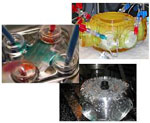 The McGowan Institute for Regenerative Medicine is pleased to introduce the McGowan Medical Device Prototype Laboratory (MMDPL). Through their unique capabilities, Laboratory staff members are assisting clinicians and engineers with the translation from concept to functional prototype of clinically significant devices and instrumentation. By using the team’s experience in the utilization of advanced engineering tools and manufacturing processes, their unique implementation strategies will form a novel bridge network of facilities to streamline the “Insight to Product” process.
The McGowan Institute for Regenerative Medicine is pleased to introduce the McGowan Medical Device Prototype Laboratory (MMDPL). Through their unique capabilities, Laboratory staff members are assisting clinicians and engineers with the translation from concept to functional prototype of clinically significant devices and instrumentation. By using the team’s experience in the utilization of advanced engineering tools and manufacturing processes, their unique implementation strategies will form a novel bridge network of facilities to streamline the “Insight to Product” process.
MMDPL members will apply their extensive design and manufacturing experience to conceptual ideas by providing documented design and efficient manufacturing processes and procedures. They will also provide an initial prototype of the device for testing, including intellectual property documentation and disclosures for the University of Pittsburgh’s Office of Technology Management.
MMDPL design tools include:
- Computer Aided Design (CAD)
- Pro-Engineer, SolidWorks
- Computer Aided Manufacturing
- Computer Aided Analysis (CAE)
- Pro-Mechanica, Comsol
- Design for Manufacturability (DFM)
- Engineering Resource Planning
Typical project documentation includes: 2D and 3D drawings, details for manufacturing planning, documentation of specific parts and components, standard operating procedure documents, detailed design technology transfer, bill of materials, and cost estimates.
The MMDPL staff is available to review your concept and discuss the transformation of your idea to a functional prototype using the state-of-the-art design and fabrication resources of the MMDPL. MMDPL contacts is Brian Frankowski (frankowskib@pitt.edu, 412-383-7296).
SCIENTIFIC ADVANCES
Novel Surgical Adhesive Begins Clinical Trials in the United States
 Several years ago, McGowan Institute for Regenerative Medicine faculty members Eric Beckman, PhD, George M. Bevier Professor of Engineering in the University of Pittsburgh Department of Chemical and Petroleum Engineering, and Michael Buckley, MD, oral and maxillofacial surgeon, invented a novel medical adhesive technology. The new adhesive—now known as TissuGlu®—was designed to meet a market demand for a strong, safe tissue adhesive to improve the wound closure process.
Several years ago, McGowan Institute for Regenerative Medicine faculty members Eric Beckman, PhD, George M. Bevier Professor of Engineering in the University of Pittsburgh Department of Chemical and Petroleum Engineering, and Michael Buckley, MD, oral and maxillofacial surgeon, invented a novel medical adhesive technology. The new adhesive—now known as TissuGlu®—was designed to meet a market demand for a strong, safe tissue adhesive to improve the wound closure process.
The product positions tissues for optimal healing while minimizing fluid accumulation. To move the University of Pittsburgh-developed technology towards clinical use, Cohera Medical, Inc. was formed, and the invention rights were licensed by the University to Cohera.
Cohera Medical, Inc. recently announced that it has received Investigational Device Exemption (IDE) approval from the United States Food and Drug Administration (“FDA”) to begin a prospective, multicenter, randomized clinical trial for its lead product, TissuGlu Surgical Adhesive, in the United States.
The study will investigate the effectiveness of TissuGlu and its effect on wound drainage and associated complications in abdominoplasty surgeries. There are currently no medical devices approved by the FDA, or in pivotal clinical trials, for a synthetic adhesive indicated for approximation of tissues in large flap surgeries.
“We are pleased to have FDA approval to begin this pivotal trial that validates the biocompatibility, pre-clinical testing profile and clinical trial design of TissuGlu,” said Chad Coberly, Vice President of Clinical, Regulatory and Legal affairs of Cohera Medical. “Initiation of this study is planned in the first quarter of 2012 and will be conducted at 5 clinical sites with 150 patients, and upon favorable conclusion will allow the company to complete a PMA application for TissuGlu with the FDA.”
“IDE approval of the TissuGlu study is a significant strategic milestone for Cohera and its investors,” said Patrick Daly, President and Chief Executive Officer of Cohera Medical. “We are encouraged by the initial positive outcomes with TissuGlu in clinical studies and commercial use outside the U.S., and we look forward to working with the FDA to bring this breakthrough technology to clinicians and patients here in the United States.”
Cohera Medical recently received CE Marking approval for TissuGlu and began selling product to hospitals and surgeons in Germany in September 2011. The company plans to expand the commercial availability of TissuGlu to additional European markets in early 2012.
Research Featured on Cover of Tissue Engineering Part C: Methods
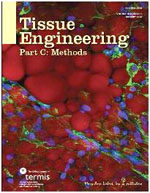 The research efforts of McGowan Institute for Regenerative Medicine faculty member Kacey Marra, PhD, associate professor, Department of Surgery, and co-director of the Adipose Stem Cell Center, University of Pittsburgh, and her colleagues McGowan Institute for Regenerative Medicine faculty members Jörg Gerlach, MD, PhD, professor, Department of Surgery, University of Pittsburgh, and J. Peter Rubin, MD, chief of the UPMC Division of Plastic and Reconstructive Surgery and director of the UPMC Center for Innovation in Restorative Medicine, and co-director of the Adipose Stem Cell Center, were featured on the cover of Tissue Engineering Part C: Methods. Their paper is entitled “Adipogenesis of Human Adipose-Derived Stem Cells Within Three-Dimensional Hollow Fiber-Based Bioreactors” and presents the development of a coherent 3D high density fat-like tissue consisting of unilocular structure from primary adipose stem cells in vitro.
The research efforts of McGowan Institute for Regenerative Medicine faculty member Kacey Marra, PhD, associate professor, Department of Surgery, and co-director of the Adipose Stem Cell Center, University of Pittsburgh, and her colleagues McGowan Institute for Regenerative Medicine faculty members Jörg Gerlach, MD, PhD, professor, Department of Surgery, University of Pittsburgh, and J. Peter Rubin, MD, chief of the UPMC Division of Plastic and Reconstructive Surgery and director of the UPMC Center for Innovation in Restorative Medicine, and co-director of the Adipose Stem Cell Center, were featured on the cover of Tissue Engineering Part C: Methods. Their paper is entitled “Adipogenesis of Human Adipose-Derived Stem Cells Within Three-Dimensional Hollow Fiber-Based Bioreactors” and presents the development of a coherent 3D high density fat-like tissue consisting of unilocular structure from primary adipose stem cells in vitro.
The abstract of the prominent article reads:
To further differentiate adipose-derived stem cells (ASCs) into mature adipocytes and create three-dimensional (3D) adipose tissue in vitro, we applied multicompartment hollow fiber-based bioreactor technology with decentral mass exchange for more physiological substrate gradients and integral oxygenation. We hypothesize that a dynamic 3D perfusion in such a bioreactor will result in longer-term culture of human adipocytes in vitro, thus providing metabolically active tissue serving as a diagnostic model for screening drugs to treat diabetes. ASCs were isolated from discarded human abdominal subcutaneous adipose tissue and then inoculated into dynamic 3D culture bioreactors to undergo adipogenic differentiation. Insulin-stimulated glucose uptake from the medium was assessed with and without TNF-alpha. 3D adipose tissue was generated in the 3D-bioreactors. Immunohistochemical staining indicated that 3D-bioreactor culture displayed multiple mature adipocyte markers with more unilocular morphologies as compared with two-dimensional (2D) cultures. Results of real-time polymerase chain reaction showed 3D-bioreactor treatment had more efficient differentiation in fatty acid-binding protein 4 expression. Repeated insulin stimulation resulted in increased glucose uptake, with a return to baseline between testing. Importantly, TNF-alpha inhibited glucose uptake, an indication of the metabolic activity of the tissue. 3D bioreactors allow more mature adipocyte differentiation of ASCs compared with traditional 2D culture and generate adipose tissue in vitro for up to 2 months. Reproducible metabolic activity of the adipose tissue in the bioreactor was demonstrated, which is potentially useful for drug discovery. We present here, to the best of our knowledge for the first time, the development of a coherent 3D high density fat-like tissue consisting of unilocular structure from primary adipose stem cells in vitro.
Generic Immunosuppressive Drug Safe for Transplant Recipients
 A new study led by McGowan Institute for Regenerative Medicine affiliated faculty member Raman Venkataramanan, PhD, professor of Pharmaceutical Sciences at the University of Pittsburgh as well as professor of Pathology within the School of Medicine and a member of the Center for Clinical Pharmacology, the Thomas E. Starzl Transplantation Institute, and director of the Clinical Pharmacokinetics Laboratory, published in the American Journal of Transplantation reveals that substitution of a brand name immunosuppressive drug with a generic drug for preventing rejection of transplanted organs appears to be safe for transplant recipients.
A new study led by McGowan Institute for Regenerative Medicine affiliated faculty member Raman Venkataramanan, PhD, professor of Pharmaceutical Sciences at the University of Pittsburgh as well as professor of Pathology within the School of Medicine and a member of the Center for Clinical Pharmacology, the Thomas E. Starzl Transplantation Institute, and director of the Clinical Pharmacokinetics Laboratory, published in the American Journal of Transplantation reveals that substitution of a brand name immunosuppressive drug with a generic drug for preventing rejection of transplanted organs appears to be safe for transplant recipients.
In addition, other McGowan Institute for Regenerative Medicine affiliated faculty members participating in the study include Ron Shapiro, MD, professor of Surgery at the University of Pittsburgh and transplant surgeon at Thomas E. Starzl Transplantation Institute, and Abhinav Humar, MD, chief of transplantation and a staff physician at the University of Pittsburgh Medical Center and also a professor in the Department of Surgery at the University of Pittsburgh School of Medicine.
Tacrolimus is an immunosuppressive drug that is used to prevent rejection of transplanted organs following organ transplantation. In August 2009, another pharmaceutical company received approval from the FDA for a generic tacrolimus product.
In the first formal study of its kind, Dr. Venkataramanan and researchers analyzed database information regarding tacrolimus concentrations and indices of liver and kidney function before and after generic substitution in 48 liver and 55 kidney transplant recipients.
Substitution of brand name tacrolimus product with the generic formulation resulted in an average reduction of 15.9% and 11.9% in concentration/dose ratio in clinically stable liver and kidney transplant patients, respectively. The substitution was safe, as no changes occurred in liver or kidney function and no acute rejection episodes occurred during the follow-up time period.
An accompanying editorial by G.B. Klintmalm of Baylor University Medical Center, while offering a different viewpoint, also calls upon the FDA to change the requirements for approval of these drugs in order for the transplant community to trust and rely on generic immunosuppressive drugs for the treatment of transplant recipients.
Klintmalm notes that “in order to safely save healthcare dollars, it is urgent that the FDA step up to the plate to implement changes in its approval process for generics of critical-dose drugs.”
“Our findings suggest that transplant patients currently taking the brand name tacrolimus formulation may be safely switched to the generic product,” Dr. Venkataramanan concludes. “However, on an individual basis, since some patients had significant changes in tacrolimus blood levels, increased monitoring of tacrolimus blood levels is necessary following the substitution to assure adequate drug concentrations. Long-term use of generic product will lead to cost savings.”
Dr. Parker Leads New NSF REU: Engineering Tools for Decision Support in Systems Medicine
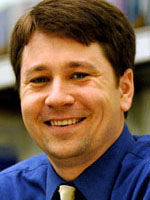 Robert S. Parker, PhD, McGowan Affiliated faculty member and Associate Professor Department of Chemical and Petroleum Engineering, Swanson School of Engineering, University of Pittsburgh is leading a new NSF REU (Research Experiences for Undergraduates) site at the University of Pittsburgh. The REU is addressing Engineering Tools for Decision Support in Systems Medicine and is designed to expose 9 undergraduates per year for three years to research in the emerging field of systems medicine. This multidisciplinary field requires a basis of knowledge in both systems engineering and biology as it applies to the human condition, such as inflammation, cancer, diabetes, etc. Undergraduates from Science, Technology, Engineering, and Mathematics (STEM) backgrounds are ideal candidates to participate in this program, and this REU site will provide a (potentially first) experience working at the interface of STEM and medicine.
Robert S. Parker, PhD, McGowan Affiliated faculty member and Associate Professor Department of Chemical and Petroleum Engineering, Swanson School of Engineering, University of Pittsburgh is leading a new NSF REU (Research Experiences for Undergraduates) site at the University of Pittsburgh. The REU is addressing Engineering Tools for Decision Support in Systems Medicine and is designed to expose 9 undergraduates per year for three years to research in the emerging field of systems medicine. This multidisciplinary field requires a basis of knowledge in both systems engineering and biology as it applies to the human condition, such as inflammation, cancer, diabetes, etc. Undergraduates from Science, Technology, Engineering, and Mathematics (STEM) backgrounds are ideal candidates to participate in this program, and this REU site will provide a (potentially first) experience working at the interface of STEM and medicine.
Students will embark on a mentored journey of research-based learning, developing along the path of dependent to independent investigator, to the degree possible for a given student. Additional objectives include the ability to deploy their modeling and analysis toolkit beyond their research problem, the ability to work in team-based research environments – a requirement for the systems medicine field – and an increased desire to continue their studies at the post-graduate level. The mentored research experience, coupled to experiences in ethics, career options, and communication and dissemination skills will provide the necessary basis for continued student contributions to the field of systems medicine and beyond.
Systems medicine problems are characterized by complex interacting systems requiring multidisciplinary knowledge to formulate and solve. The intellectual merit of this REU proposal derives from the emergence of this field and the need for experts with the knowledge and motivation to address constrained real-world problems where mathematical models can provide hypothesis-generating and in validating predictions. Furthermore, systems medicine is underserved by existing REU sites, in comparison to other areas of biomedical research, and this site would expand the existing REU repertoire while educating students who could serve as the next generation of leaders in the field. The necessity of coupling modeling and systems analysis approaches to experimental data – thereby yielding a predictive model upon validation – is a prerequisite to solving clinically-relevant systems medicine problems. Through a series of mentored research and teaching experiences, REU students will take the first step on the path to becoming the next generation of experts in the field of systems medicine.
Through this REU, Dr. Parker and his colleagues seek to actively recruit underrepresented undergraduates to participate in interdisciplinary research and to advance the abilities of all students in the program with respect to communication, teamwork, and professional skills. Through existing relationships, and the development of new ones with minority, female, or primarily undergraduate institutions, this REU looks to provide a pathway to graduate education for populations that are traditionally underrepresented at the engineering (and STEM) post-graduate level by fostering the ability to independently and collaboratively investigate systems medicine research problems. One path of dissemination is to design simulations for use in K-12 education; the RUE is partnering with the CTSI “Mobile Lab” to bring computational experiments to K-12 students in an effort to stimulate the desire of these students to pursue STEM subjects at the baccalaureate level.
Patents Awarded to McGowan Institute for Regenerative Medicine Affiliated Faculty Members
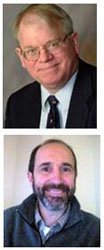 McGowan Institute for Regenerative Medicine affiliated faculty members Ernest Manders, MD, residency program director for the Division of Plastic Surgery, medical director of the Facial Nerve Center, chief of plastic surgery at the Oakland VA Hospital, and plastic surgery chief of the University of Pittsburgh Cranial Base Surgery Program, and David Schwartzman, MD, professor of medicine at the University of Pittsburgh, member of the UPMC Cardiovascular Institute, and director of the UPMC Atrial Fibrillation Center, were recently awarded U.S. patents for their inventions. Dr. Manders developed a patent for a dimensionally adjustable soft tissue expander for expanding breast skin. Dr. Schwartzman is a co-inventor of a device and method of use for functional isolation of heart tissues
McGowan Institute for Regenerative Medicine affiliated faculty members Ernest Manders, MD, residency program director for the Division of Plastic Surgery, medical director of the Facial Nerve Center, chief of plastic surgery at the Oakland VA Hospital, and plastic surgery chief of the University of Pittsburgh Cranial Base Surgery Program, and David Schwartzman, MD, professor of medicine at the University of Pittsburgh, member of the UPMC Cardiovascular Institute, and director of the UPMC Atrial Fibrillation Center, were recently awarded U.S. patents for their inventions. Dr. Manders developed a patent for a dimensionally adjustable soft tissue expander for expanding breast skin. Dr. Schwartzman is a co-inventor of a device and method of use for functional isolation of heart tissues
Dr. Manders’ invention is an improved soft tissue expander with an adjustable base which maintains its shape during implantation and expansion so that the size of the expanded overlying skin and soft tissue expanded is determined by the size and shape of the expander base selected by the surgeon before the expander is implanted. A single expander may be used to expand different size areas of skin and soft tissue by adjusting the shape of the base prior to implanting the expander under the skin and soft tissue to be expanded.
An expander according to the invention is useful in expanding skin and soft tissue overlying the breast of the patient prior to implanting a breast prosthesis. This procedure forms a shaped layer of skin and soft tissue conforming to the shape of the breast and having sufficient area to replace the skin removed from the lower pole of the breast during a mastectomy. Accurate shaping of the expanded skin and soft tissue to simulate the natural breast is critically important to the success of the procedure.
The use of an adjustable base expander according to the invention for expanding breast skin and soft tissue permits the surgeon to use one expander for patients having different sized breasts with the base of the expander adjusted before implantation to meet the requirements of the particular patient. The size of the expander base is readily adjusted and does not change during implantation and inflation of the expander and overlying skin and soft tissue. The expander is also useful in other soft tissue expansion procedures.
Dr. Schwartzman is the co-inventor of a device and method of use for functional isolation of animal or human tissues of the heart. Embolic stroke is the nation’s third leading killer for adults and a major cause of disability among older Americans. There are over 80,000 strokes per year in the United States alone. A common cause of embolic stroke is thrombus formation in the heart resulting from stagnant blood flow that occurs as a result of atrial fibrillation. Atrial fibrillation (“AF”) is an extremely deleterious condition resulting in chaotic cardiac rhythms that typically precipitate lower cardiac output and irregular blood flow in various regions of the heart. There are over 5 million people worldwide with AF and about 400,000 new cases reported each year. Patients with AF are at approximately a 500 percent greater risk of embolic stroke due to the condition. Though pharmacologic treatments of AF are common, they are palliative rather than curative. Furthermore, a patient with AF commonly experiences a significantly decreased quality of life due, in large part, to the fear of a stroke and lifestyle restrictions associated with the attendant pharmaceutical regimen.
Patients with AF often develop thrombus in the left atrial appendage (LAA) of the heart. The LAA is a protrusion which looks like a small finger or windsock extending from the lateral wall of the left atrium between the mitral valve and root of the left pulmonary vein. The interior of the LAA is open to the left atrium allowing blood to flow from the left atrium into the appendage. The physiological function of the LAA is not fully understood. However it is known to be highly innervated indicating that it may have some neurological role. The LAA is also known to secrete substances leading to various theories of its endocrine and/or paracrine nature. Further, the LAA may function as a physical compliance chamber for the left atrium.
Direct surgical and thorascopic techniques have been used to obliterate the LAA. Nonetheless, many patients are unsuitable candidates for such surgical procedures due to a compromised condition (e.g. mitral valve disease) or those having previously undergone cardiac surgery. Furthermore, the perceived risks of even thorascopic surgical procedures often outweigh the potential benefits of this treatment modality.
What has been needed is a less invasive atraumatic method and device for isolating, excluding, closing or occluding a target tissue, body lumen, or appendage. Specifically, it would be desirable to provide an epicardial device and method for containment or elimination of thrombus formation in the LAA of patients with atrial fibrillation. The present invention satisfies these and other needs.
A further aspect of the present invention is directed to devices and methods for functional isolation of tissue, by mechanical and/or electrical, radiative, chemical, or thermal means; particularly, isolation of the LAA, preferably by external/epicardial capture, manipulation, stabilization, and attachment of a closure device to the base of the LAA. One purpose of mechanically occluding the orifice between the LAA and the left atrium is to prevent formation within, or passage of embolic material from, the LAA into the left atrium and hence, into the bloodstream of a patient. Entry of these emboli into the patient’s blood stream can have deleterious consequences including cerebral stroke.
AWARDS AND RECOGNITIONS
Carnegie Science Center Awards for Excellence
 The Pittsburgh Carnegie Science Center established the Awards for Excellence program in 1997 to recognize and promote outstanding science and technology achievements in Western Pennsylvania. Celebrating its 16th year, the Carnegie Science Awards have honored the accomplishments of more than 300 individuals and organizations that have improved lives through their commitment and contributions in science and technology. Award winners were announced on February 2, 2012. On May 11, 2012, at the Carnegie Music Hall the following award recipients from the McGowan Institute will be honored for their tremendous work and its impact on the vitality in the region:
The Pittsburgh Carnegie Science Center established the Awards for Excellence program in 1997 to recognize and promote outstanding science and technology achievements in Western Pennsylvania. Celebrating its 16th year, the Carnegie Science Awards have honored the accomplishments of more than 300 individuals and organizations that have improved lives through their commitment and contributions in science and technology. Award winners were announced on February 2, 2012. On May 11, 2012, at the Carnegie Music Hall the following award recipients from the McGowan Institute will be honored for their tremendous work and its impact on the vitality in the region:
- Advanced Materials Award: Eric Beckman, PhD, the George M. Bevier professor of Engineering in the University of Pittsburgh Department of Chemical and Petroleum Engineering
- Start-Up Entrepreneur Award: Nick Kuhn, president and chief business officer, ALung Technologies, Inc. (ALung is a licensee of technology developed by William Federspiel, PhD and the late Brack Hattler, MD, PhD)
- Life Sciences Award: Joel Schuman, MD, the Eye and Ear Foundation professor and chairman of Ophthalmology, director of the UPMC Eye Center, and interim director, the Louis J. Fox Center for Vision Restoration
- University/Post-Secondary Student Award, Honorable Mention: Sam Rothstein, Department of Chemical Engineering, University of Pittsburgh
The Advanced Materials Award recognizes accomplishments in materials science that create new materials or properties leading to significant business, economic, or societal benefits for the region. Dr. Eric Beckman is the inventor of a new surgical adhesive, TissuGlu®. (see”Novel Surgical Adhesive Begins Clinical Trials in the United States” above for details)
The Start-Up Entrepreneur Award recognizes leadership in developing a promising innovation in an early-stage company. Mr. Nick Kuhn is the president and chief business officer, ALung Technologies, Inc. ALung, in Pittsburgh, is developing the HemoLung™, which is an extracorporeal gas exchange device that circulates blood via a small catheter out of the body through a cartridge in a therapy similar to kidney dialysis. The technology was developed by McGowan Institute for Regenerative Medicine faculty member William Federspiel, PhD, the William Kepler Whiteford Professor of Chemical Engineering, Surgery and Bioengineering, University of Pittsburgh, and director, Medical Devices Laboratory: Biotransport, Pulmonary and Cardiovascular, McGowan Institute, and the late Brack Hattler. By directly delivering oxygen to the blood and removing carbon dioxide from the blood, the HemoLung™ provides a superior clinical and cost-effective solution when compared to a conventional ventilator (respirator) used in an ICU. The HemoLung™ is designed to support patients with acute breathing problems, providing their lungs a bridge to recovery much more efficiently and safely than is currently done. There are currently 450,000 patients in the U.S. that are ventilated each year for temporary, acute respiratory failure, resulting in a potential annual market of $2.7 billion. ALung also expects that the HemoLung™ will be a supplement to accelerate healing for patients with Acute Respiratory Distress Syndrome (ARDS; injured lungs).
Life Sciences Award recognizes and honors scientific advances in new and innovative biomedical and life sciences endeavors. The research of Dr. Joel Schuman focuses on the early detection of disease and its progression and the invention of novel diagnostics for eye disease, most specifically for glaucoma. Determined to find a method of diagnosing glaucoma before symptoms become present, Dr. Schuman pioneered the development of optical coherence tomography (OCT), which to date is the most powerful tool available for early detection of the disease. Dr. Schuman is responsible for regularly upgrading this technology, now known as Spectral Domain OCT, which quickly and noninvasively produces a 3-D map of the eye and compares it to images of what healthy eye tissue should look like. OCT is now used worldwide for ocular diagnostics. OCT provides tissue morphology imagery at much higher resolution (better than 10 µm) than other imaging modalities, such as MRI or ultrasound. No special preparation of eye tissue is required, and images can be obtained ‘non-contact’ or through a transparent window or membrane – providing diagnostic capabilities never available before Dr. Schuman’s invention.
In addition, Dr. Schuman and his colleagues were the first to identify a molecular marker for human glaucoma, as published in Nature Medicine. This discovery has provided the pathway to significant advances in the treatment and diagnosis of glaucoma, a disease that affects 17 million people, and is the number one cause of preventable blindness. Glaucoma is virtually symptom-free in its early stages. This identification of the molecular marker for glaucoma, has paved the way for other significant advances in the diagnosis and treatment of the disease. OCT has changed the clinical practice of ophthalmology, allowing non-invasive in vivo objective, quantitative assessment of ocular pathologies. Dr. Schuman’s work has resulted in the publication of 27 OCT-related peer-reviewed scientific papers in high level journals, including Science and Nature Medicine. The discovery of the molecular marker for human glaucoma was a major milestone. As noted above, early detection of glaucoma has been a problem. Various population-based epidemiological studies have reported that more than 50% of glaucoma cases remain undiagnosed, even in developed countries. High prevalence of undiagnosed glaucoma is consistent with the lack of cost-effective screening methods for glaucoma. Molecular markers are paving the way to better and lower cost screening tools.
The University/Post-Secondary Student Award recognizes scientific advances through research, effectiveness in increasing the public awareness of the role of science or engineering to society, and inspiring youth in the promotion of career opportunities. Mr. Sam Rothstein is a PhD student in the laboratory of Steven Little, PhD–Department of Chemical Engineering at the University of Pittsburgh. He is responsible for the development of the first mathematical model that can be used to predict controlled release of practically any drug from degradable polymer matrices. Mr. Rothstein’s mathematical models eliminate months of experiments in the design of long-acting, controlled-release medications. For a single medication, this could translate to a savings of nearly $1 million in R&D costs and $400 million in patent-protected sales revenue. The efficiency of Mr. Rothstein’s models has already helped researchers at the University of Pittsburgh develop a once-a-month glaucoma treatment (to replace one given 3 times daily) and a first-in-class medication for periodontal disease. Widespread adoption of these methods could bring to market hundreds of other medications that improve patient safety and adherence, barriers responsible for 10% of hospitalizations and over $100 billion in annual medical expenses.
Mr. Rothstein’s most recent publication entitled “A Tool Box for Rational Design of Degradable Controlled Release Formulations” was chosen as a feature review article and made the cover of the Journal of Materials Chemistry in early 2011. His extraordinary effort and persistence in his graduate work has resulted in an impressive number of awards for a graduate student including an NIH T32 Fellowship, the Fisher-Scientific Biomedical Engineering Research Award, the Society for Biomaterials’ STAR Award, and the Sunoco Chemicals Award (just to name a few). Furthermore, Mr. Rothstein has won even more awards as a result of translating his technology into a new, Pittsburgh-based startup company (ChroKnow Inc.) including the Idea Foundry’s Commercialization Award, a University of Pittsburgh Big Idea Award, and two separate first place prizes in two difference elevator pitch competitions. Mr. Rothstein is a rare example of a graduate student that has gone beyond excellence in academics to excellence in entrepreneurship.
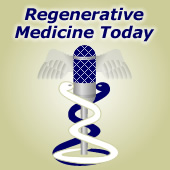 Regenerative Medicine Podcast Update
Regenerative Medicine Podcast Update
The Regenerative Medicine Podcasts remain a popular web destination. Informative and entertaining, these are the most recent interviews:
#105 –– Adam Feinberg, PhD and Rachelle Palchesko, PhD –– Dr. Adam Feinberg is the principal investigator of the Regenerative Biomaterials and Therapeutics Group at Carnegie Mellon University. Dr. Palchesko is a Postdoctoral Research Fellow in the group. Drs. Feinberg and Palchesko discuss the development of basement membranes and the regeneration of corneal endothelium.
Visit www.regenerativemedicinetoday.com to keep abreast of the new interviews.
Publication of the Month
| Authors: | Gerlach JC, Lin YC, Brayfield CA, Minteer DM, Li H, Rubin JP, Marra KG. |
| Title: | Adipogenesis of human adipose-derived stem cells within three-dimensional hollow fiber-based bioreactors. |
| Summary: | To further differentiate adipose-derived stem cells (ASCs) into mature adipocytes and create three-dimensional (3D) adipose tissue in vitro, we applied multicompartment hollow fiber-based bioreactor technology with decentral mass exchange for more physiological substrate gradients and integral oxygenation. We hypothesize that a dynamic 3D perfusion in such a bioreactor will result in longer-term culture of human adipocytes in vitro, thus providing metabolically active tissue serving as a diagnostic model for screening drugs to treat diabetes. ASCs were isolated from discarded human abdominal subcutaneous adipose tissue and then inoculated into dynamic 3D culture bioreactors to undergo adipogenic differentiation. Insulin-stimulated glucose uptake from the medium was assessed with and without TNF-alpha. 3D adipose tissue was generated in the 3D-bioreactors. Immunohistochemical staining indicated that 3D-bioreactor culture displayed multiple mature adipocyte markers with more unilocular morphologies as compared with two-dimensional (2D) cultures. Results of real-time polymerase chain reaction showed 3D-bioreactor treatment had more efficient differentiation in fatty acid-binding protein 4 expression. Repeated insulin stimulation resulted in increased glucose uptake, with a return to baseline between testing. Importantly, TNF-alpha inhibited glucose uptake, an indication of the metabolic activity of the tissue. 3D bioreactors allow more mature adipocyte differentiation of ASCs compared with traditional 2D culture and generate adipose tissue in vitro for up to 2 months. Reproducible metabolic activity of the adipose tissue in the bioreactor was demonstrated, which is potentially useful for drug discovery. We present here, to the best of our knowledge for the first time, the development of a coherent 3D high density fat-like tissue consisting of unilocular structure from primary adipose stem cells in vitro. |
| Source: | Tissue Eng Part C Methods. 2012 Jan;18(1):54-61. Epub 2011 Oct 18. |
Grant of the Month
| PI | Stephen F. Badylak | |
| Co-PI | William R. Wagner | |
| Title | Optimization of Surgical Mesh Materials | |
| Description |
|
|
| Source | CR Bard | |
| Term | 01/01/12 – 12/31/12 | |
| Amount: | $600,000 |
Newsletter Comments or Questions: McGowan@pitt.edu
